Chickens and ducks are both poultry birds and are often of nearly equal size. Since they typically eat the same feed and treats, many homesteaders have wondered if both types of birds can live together in the same coop and run.
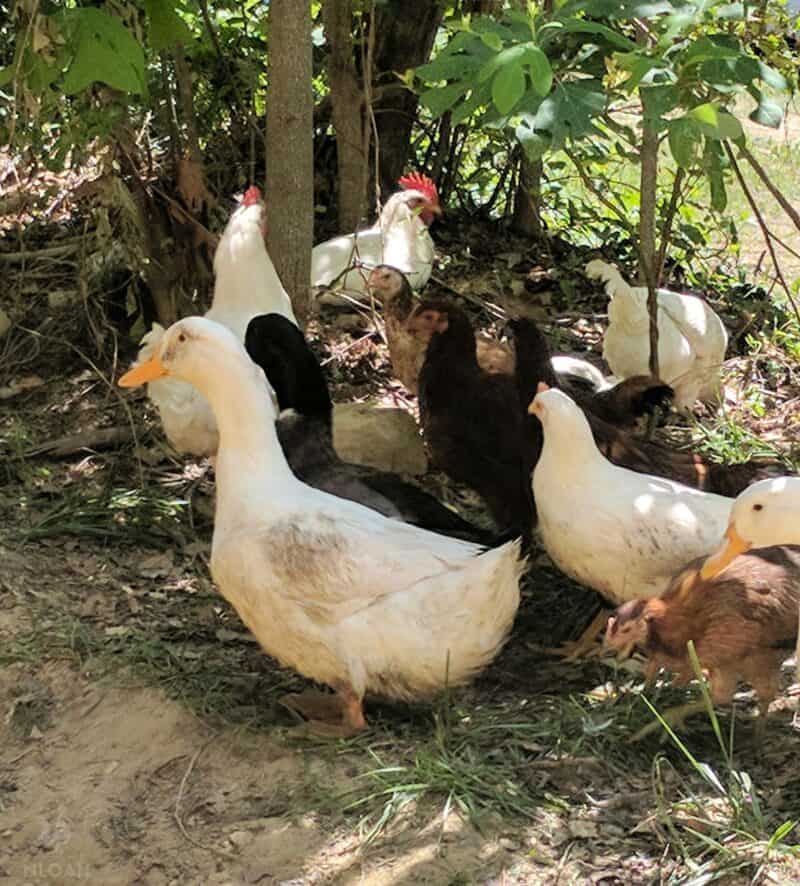
Yes, chickens and ducks can usually live together. How early the poultry birds begin to cohabitate and to some degree, what breeds are sharing living quarters, play a huge role in how successfully you will be able to place both in the same coop and run.
Except for a very short while when we were small-town homesteaders, I’ve always raised chickens and ducks together. Once we purchased our dream 56-acre homestead, we began hatching our own birds, and purchasing chicks and ducklings in greater numbers.
Can Ducklings and Chicks Be Together?
This is a complicated issue, but I don’t think it has to be. The bottom line is that I don’t recommend you allow ducklings and chicks to be together until they’re old enough to join their respective flocks. There are just too many opportunities for trouble to start from overprotective parents and then roosters or drakes rushing in to the rescue when that starts.
Likewise, although I’ve seen successes about letting hens of both species to share a coop for nesting purposes, I advise a lot of caution: ducks always nest on the ground whereas chickens might do the same or choose an elevated nesting box if it’s available.
Trouble starts when a duck accidentally sits down on a nest of chicken eggs: ducks are heavy-footed and heavier birds in general, and it’s all but certain that they will crack the far more delicate chicken eggs when this happens.
Chickens can successfully hatch duck eggs, but only the smallest duck breeds can hatch chicken eggs without breaking them…
This isn’t even going into the intricacies of what will happen when a broody hen of either species takes offense to the presence of the other.
It doesn’t mean you can’t make it work, but you’re going to have to work a whole lot harder than you would normally to collect eggs or expand your flock naturally.
Can You Raise Ducklings and Chicks in the Same Brooder?
Ideally, no. Chicks hatch at least a week quicker than ducks, and the conditions for both to develop properly and healthily, concerning temperature and humidity, are different.
Usually, it is the chickens that can cause the most harm when they are living with ducks. Their sharp beaks and later on, as they mature, the spurs on the rooster could tear a duck to shreds.
Separate brooder boxes, and separate controls, if you want to incubate your own ducks and chickens alongside each other. Trying to do otherwise could spell disaster, though not necessarily!
I had placed my chicks and ducklings in the same brooder from the start. Only when there was a substantial size difference between the birds did I ever have any concerns about chickens and ducks living together.
As you can see in the photo below, I had ducklings that were a lot larger than the chicks they were sharing a brooder with during one hatching season. The ducklings were a surprise from my daughter – she didn’t realize how much larger they were than the chicks during her shopping spree at Rural King.
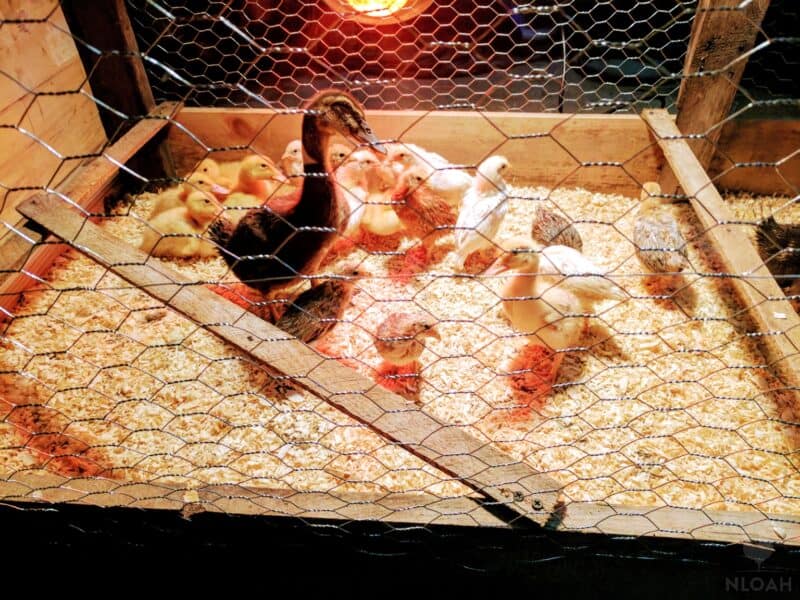
After allowing the ducks to walk around the brooder and interact with the chicks for about 10 minutes, my husband placed them inside for a test run.
I stood at the ready to gently yet quickly snatch the ducklings out of the brooder at the first sign of trouble, but none materialized. While the ducklings look and seem really docile, they can grab a hold of a chick’s dainty wings with their surprisingly strong beaks and rip them clean off in mere seconds.
Living Quarters
The size of the chicken coop and run can make all the difference when putting the two together. When forced into tight confines, the chances of problems greatly increase. If a rooster doesn’t have a hen to mate with, it WILL attempt to procreate with a female duck.
Nothing good would come from such a coupling, and you likely end up with an injured duck hen in the process if the rooster is aggressive and digs its spurs into the back of the duck to hold it still.
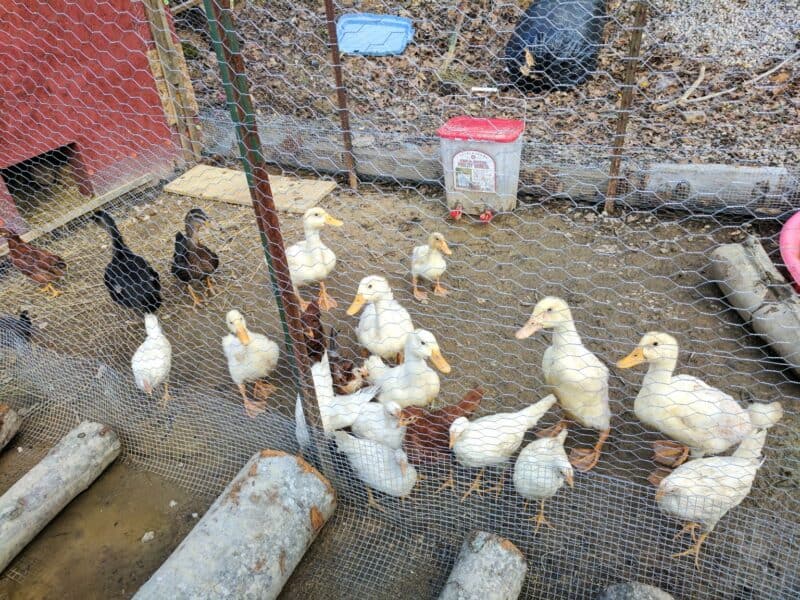
Nesting Areas
Chickens and ducks will need separate nesting areas when living together. Chickens prefer to perch and most types of domesticated or meat ducks can’t fly – not really.
Ducks should be provided with nesting boxes at ground level to sleep and lay their eggs in… if you are lucky. Ducks tend to drop their eggs all around the coop and chicken run.
A duck nesting box can be made quickly and cheaply by filling an old tire or plastic tub or bucket with straw. Mound the straw, or even dirt, slightly over the tower when making a nesting box. In my personal experience, ducks prefer a mound-style nesting box.
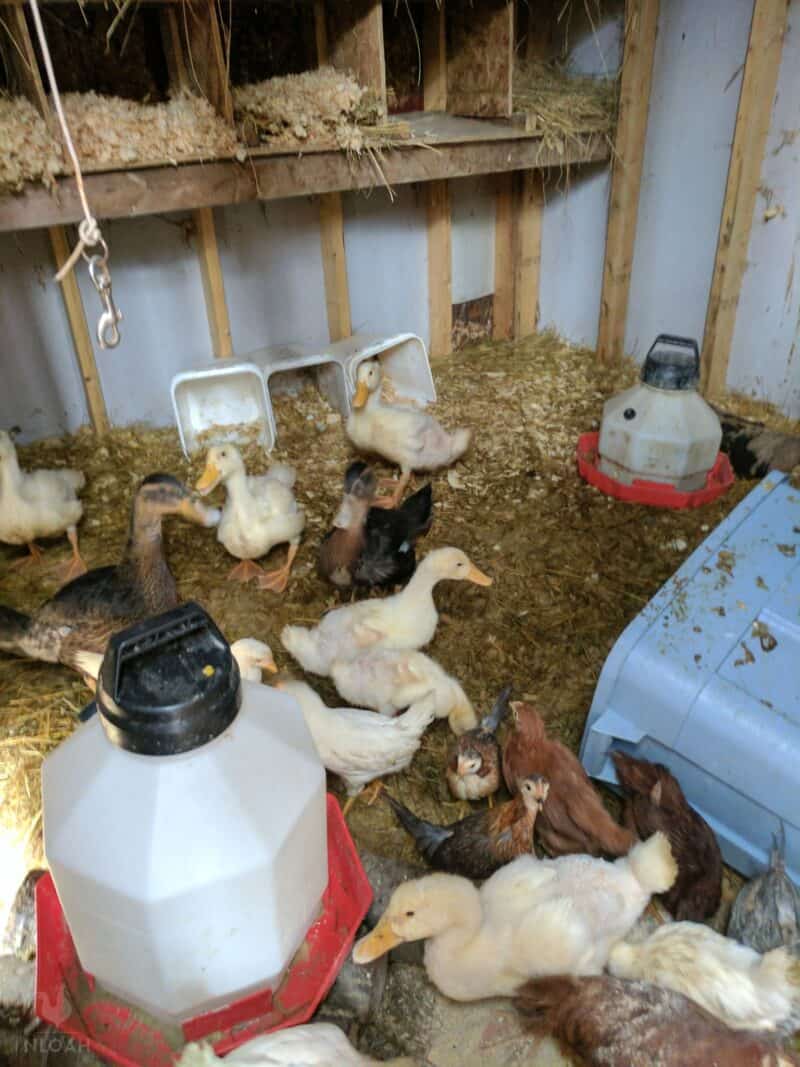
Ducks Don’t Roost
That’s right, ducks don’t roost. They sleep on the ground or slightly elevated on a flat surface, but that’s it. Chickens, on the other hand, roost on bars when they sleep.
This can allow you to maximize usable space in a coop, but you’ve got to provide enough room for each species to access their sleeping spot without disturbing the other.
Ducks Handle Cold Better
You might not know this, but ducks are little heat boxes. And even though the inside of a properly-built chicken coop is toasty warm, ducks will significantly heat up the space.
Ducks can handle a much colder shelter compared to chickens, so just because you have one suitable for ducks, it doesn’t mean it’s okay for your chickens.
A Shared Coop Needs More Ventilation
Because ducks run so much warmer compared to chickens, and because they tend to increase the humidity inside the coop, the coop will need additional ventilation up at the roof level.
This will be necessary for temperature regulation and the lowering of humidity, but preventing too much heat loss can be challenging.
Again, ducks might be plenty comfortable in a coop that’s misery for chickens, so expect to experiment to get this right.
Ducks Tend to be a Bit More Active at Night
A potential problem though not necessarily a likelihood is that ducks tend to be a little bit more active during the times when chickens are settling down to go to bed.
If you put up both at the same time, this could lead to some squabbling before they get some shut-eye. Nighttime stress can lead to a devastating chain reaction of agitation that can have all of your birds in an uproar.
Can Ducks and Chickens Share a Run?
Yes, and if all else fails, you can generally rely on the fact that chickens and ducks can easily get along in a run together as long as you’ve got plenty of room.
However, ducks have unique quirks that must be accommodated, and more so they must be accommodated without upsetting or harming the chickens.
Ducks Must Have Access to Deeper Water
Ducks must have access to deeper water for swimming, preening, and flushing their beaks and sinuses. Deep water can be a hazard for chickens though.
Provide Enough Room for Both Species to Separate
Compared to having only a single species, you need to allow extra room in the run for ducks and chickens to separate from each other and hang out with their own kind.
Though they will mingle periodically, they generally keep to themselves. Talk about the space requirements of both species generally.
Ducks Don’t Have a Strict Pecking Order Like Chickens
You’ll find that ducks aren’t as hierarchical as chickens. Not only do ducks get along better between themselves, with the exception of drakes and mating rights, ducks generally don’t get subjected to the tyranny of bossy chickens either.
With a little luck, the presence of larger ducks might serve as peacemakers for chickens.
Don’t expect ducks to spend any more time in the coop than absolutely necessary. They prefer to be outdoors and on water. You can dig a small pond in your chicken run to suit the ducks, or simply put a plastic baby pool in the living area for them to splash around in.
When adding a water feature to the poultry run, make sure that it isn’t so deep that chickens can wander or fall into it and drown.
When I first relocate chickens and ducks from their brooder and into the coop, I place a cinder block or float a log in the baby pool to give the chickens something to hop onto in case they fall in after perching on the sides of the plastic baby pool – which you should expect them to do with great frequency.
If you free-range your flock, like I do, the chickens and ducks will be able to separate out into their own individual mini-flocks as they see fit, which also reduces the chances of fighting or injury.
You might just be surprised at how often the chickens and ducks choose to hang out together and forage around the barnyard.
If you also choose to add guineas to the living arrangement, they will look at the other birds as their charges and help both protect and herd them if danger is nearby on either the ground or in the air (eg. hawks).
When first placing a brooder batch into a coop with an established flock of chickens and ducks that are living together, do so slowly. I like to keep the brooder right next to the coop run so the birds are constantly around each other and already feel like a flock from day one.
Whenever possible, I allow the chickens and ducks to hatch their own offspring instead of using an incubator. The mother hen or mother duck and her little ones get to live in an area of their own until the chicks or ducklings are large enough to join the established flock.
When they are melded in with the mature chickens and ducks, they have the added protection of their momma to help ensure a smooth transition.
Feeding
Ducks and chickens have very similar but still distinct nutritional requirements. The easy way to square it is thus: chickens and ducks can both eat each other’s food safely, but they really need their own food for optimum health.
Ducks Should Never Eat Medicated Chicken Feed!
Many types of commercial chicken feed are medicated, containing things to help chickens cope with common infections, parasites, and more.
The problem is that ducks eat a lot more than chickens do, and if they eat medicated chicken feed it is very easy for them to overdose with potentially fatal results.
If you’re going to cohabitate your chickens and ducks together, you’re highly advised to switch to a non-medicated chicken feed to prevent this outcome. You’ll have to administer any needed medications in some other way.
Ducks and Chickens Can Eat the Same Grit
The good news is that chickens and ducks can make use of the same types of grit. If you have adequate grit in the run, they’ll both get it when they need it. Likewise, if either variety of food contains added grit you don’t need to worry about that affecting the other species.
Ducks Must Have Water in Order to Eat Safely
Here’s where things really start to get sticky if you want ducks around your chickens…
Chickens and ducks both need water, of course, but ducks have to have water in order to eat safely. This is because they scoop up food in their bills, dunk their heads in water to swish it and moisten it, and then swallow.
Accordingly, most standard waterers are inadequate for ducks, and they really need an open tub or container that is easy for multiple ducks to access comfortably at once for feeding time.
Keeping an open container like this near the food, for chickens or ducks, is a great way to get it soaked and ruined so you should consider keeping separate feeding stations for both birds and hope that they use them.
Ducks Make a Terrible Mess When They Eat
Another one of the few downsides to ducks is that they make a dreadful mess when they eat.
I mentioned that they dip their heads to moisten their food, but the way that they swish it around and flick water everywhere is going to get a much larger area than you think soaking wet.
This will happen every day, multiple times a day. Your chickens won’t need much incentive to stay away, but it won’t fail that you’ll have a muddy patch in the immediate area surrounding where the ducks hang out. It’s just the way it is, and it doesn’t matter how hard you try.
Have a plan for remediating this if you don’t want your flock to get filthy.
Do Drakes and Roosters Get Along?
You’d think that the sexually intact and aggressive males of each species would be at each other’s throats from the get-go, but in my experience, this isn’t the case in mixed flocks.
However, you’ll have to pay even more attention to balancing the genders in each of the respective flocks in order to maintain cohabitative harmony.
A Lack of Respective Females Can Cause Stress
If you’re going to have a drake for your ducks or a rooster for your chickens, you’ve got to add their counterpart to the other flock.
That’s just the way it is, as it’s pretty much the only way to establish a sort of watchful peace between the two. And accordingly, you need the right number of females for each.
A rooster should have access to anywhere from 7 to 10 hens, and a drake needs at least 2 females – preferably 3. So long as the males of each flock aren’t at each other’s throats, there should be peace between the two species.
Don’t Hesitate to Separate Troublemakers
Something that chicken keepers are already acquainted with is the fact that sometimes males just won’t get along. They don’t get along with other males or with females!
If you have a drake or a rooster that has turned tyrannical, this will once again lead to a spiral of stress and abuse they can have all of your birds in a ruffled, flustered state of discontent.
Be prepared to set up a paddock or an entirely separate coop and run for troublemakers to form a colony for roosters or drakes respectively…
Separate Coops Can Lead to Harmony in the Run
I’ll warn you, trying to house mixed flocks consisting of both males and females can get very interesting.
Drakes and roosters alike get pretty territorial over resting grounds, and unless you have a very large coop it might be an impossibility.
However, you might not need two separate pens and runs if you have space enough to build a separate coop so both flocks have their own customized area to rest at night.
As long as everybody’s getting plenty of rest, you’ll find they are less stressed and less hateful when they are together in a shared run.
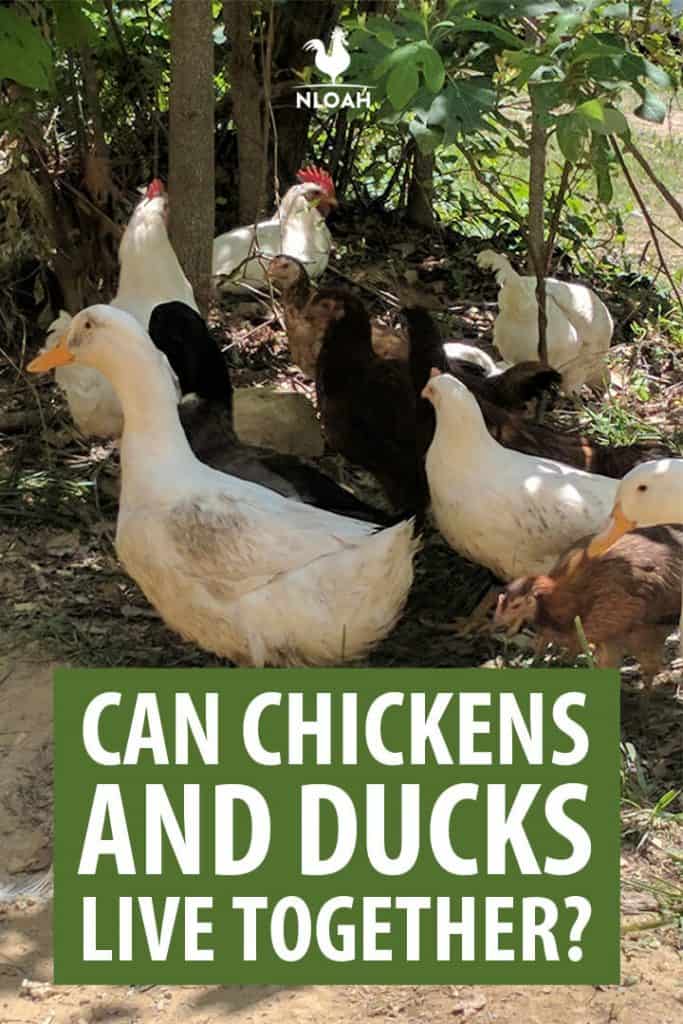

Tara lives on a 56 acres farm in the Appalachian Mountains, where she faces homesteading and farming challenges every single day, raising chickens, goats, horses, and tons of vegetables. She’s an expert in all sorts of homesteading skills such as hide tanning, doll making, tree tapping, and many more.

I’ve raised chickens and ducks together before and they’ve always gotten along fine. The biggest issue is managing water. A 2 to 3 gallon gravity chicken water fountain will happily keep a small flock of 15 or so chickens watered for 2 days, whereas one adult or adolescent duck can drain it in a couple of hours and make a mess in the process. You need to come up with something that both species can drink out of, and that ducks can wash their heads and necks in, but can’t climb into and otherwise make a mess with. Also, you need your coop built in such a way that the ducks can use it too. With the possible exception of Muscovies, ducks can’t climb a chicken ladder or steep ramp to get into a coop that has a raised floor. Even though they get along fine, sometimes it’s easier to raise the two species separately because of these issues. However, I would never raise turkeys together with chickens because of diseases.
How sweet – and yes a strange sight to behold I am sure. My white leghorn rooster, known affectionately (at least by me) as Flockleader, likes to fly up and sit on my shoulder when I am scooping feed out of the old fridge we laid sideways to use as a tub and eats treats from my hand. With everyone else other than the grandkiddos, he is a miniature attack beast, lol.
We live in rural upper state New York, and have lots of wild turkeys in the area. One flock of turkeys has adopted a white leghorn, and it has gone everywhere that they have for past couple of years. It’s a strange sight, but they all get along great together.